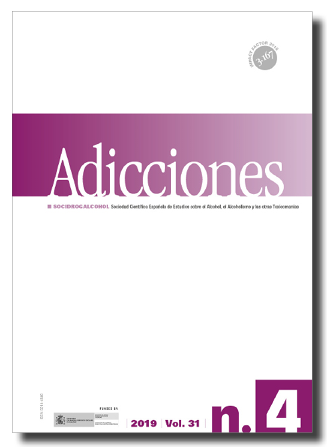Smoking cessation interventions in substance use treatment facilities: clinical implications and recommendations for implementation
DOI:
https://doi.org/10.20882/adicciones.1270Keywords:
Smoking, Smoking cessation, Substance use dependents, Barriers, Organizational changesAbstract
There exists an increasing recognition that smoking cessation treatments should be provided alongside substance abuse treatments. However, very scarce evidence of this practice has been reported in Spain. This study sought to provide data on the provision of smoking cessation treatments within substance use treatment facilities in Asturias, Spain. A total of 15 treatment facilities were contacted initially. An ad hoc survey was provided to the principal coordinator of each substance use treatment facility to collect data on the provision of smoking cessation treatments, centers’ restrictions on tobacco use, and barriers to effectively implementing smoking cessation treatments. Of the surveyed centers, only 3 systematically offered smoking cessation treatments. A total of 10 out of 15 centers (66.66%) self-reported any tobacco control measure: banning cigarette exchange (4/10; 40%), limiting time for rolling cigarettes (4/10; 40%), using cigarettes as a prize/punishment (2/10; 20%), and cigarette collection at night (1/10, 10%). Barriers to effectively implementing smoking cessation treatments have been identified at different levels (staff, patient, and organizational). Concerns that smoking abstinence would compromise substance use outcomes were detected as the main barrier to effectively implementing smoking cessation treatments within centers. Several clinical implications are discussed.References
Becoña Iglesias, E., García García, V., de Echave Sanz, J., Fernández Miranda, J., Sánchez Fernández, M., Terán Prieto, A., . . . Castillo, A. (2006). Tratamiento del tabaquismo en los centros de drogodependencias y alcoholismo en España. Estado de la situación y perspectivas futuras. Adicciones, 18, 23-28. doi:10.20882/adicciones.353.
Cohn, A., Elmasry, H. y Niaura, R. (2017). Facility-level, state, and financial factors associated with changes in the provision of smoking cessation services in US substance abuse treatment facilities: Results from the national survey of substance abuse treatment rervices 2006 to 2012. Journal of Substance Abuse Treatment, 77, 107-114. doi:10.1016/j.jsat.2017.03.014.
Consejería de Sanidad del Gobierno del Principado de Asturias. (2016). Guía de recursos en drogodependencias del Principado de Asturias (cuarta edición). [Guide to resources on drug addiction of the Health Council of the Principality of Asturias, fourth edition]. Recuperado de https://www.astursalud.es/documents/31867/36150/Gu%C3%ADa+de+recursos+en+drogodependencias.pdf/efa9e9d3-5013-0cf1-0ccb-bb8a64bd04ab.
Nieva, G. y Gual, A. (2005). El tratamiento del tabaquismo en alcohólicos: ¿miopía o negligencia? Adicciones, 17, 177-180. doi:10.20882/adicciones.366
Prochaska, J. J., Delucchi, K. y Hall, S. M. (2004). A meta-analysis of smoking cessation interventions with individuals in substance abuse treatment or recovery. Journal of Consulting and Clinical Psychology, 72, 1144-1156. doi:10.1037/0022-006X.72.6.1144.
Skelton, E., Tzelepis, F., Shakeshaft, A., Guillaumier, A., McCrabb, S. y Bonevski, B. (2018). Integrating smoking cessation care in alcohol and other drug treatment settings using an organizational change intervention: a systematic review. Addiction, 113, 2158-2172. doi:10.1111/add.14369.
Weinberger, A. H., Gbedemah, M., Wall, M. M., Hasin, D. S., Zvolensky, M. J. y Goodwin, R. D. (2018). Cigarette use is increasing among people with illicit substance use disorders in the United States, 2002-14: emerging disparities in vulnerable populations. Addiction, 113, 719-728. doi:10.1111/add.14082.








